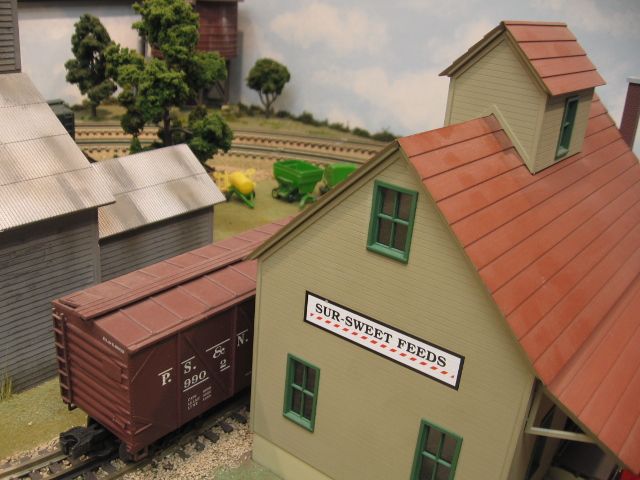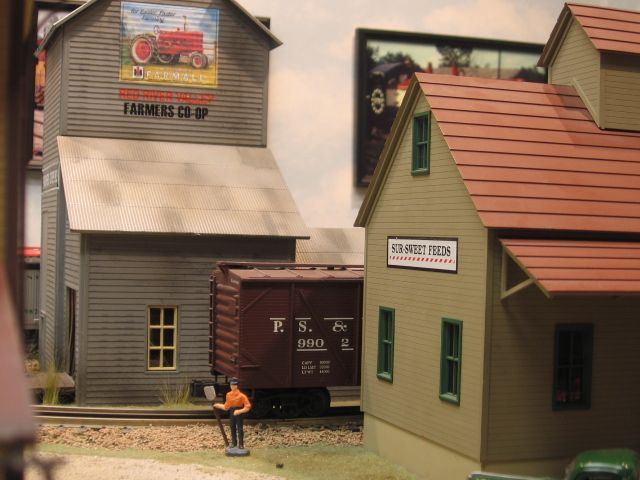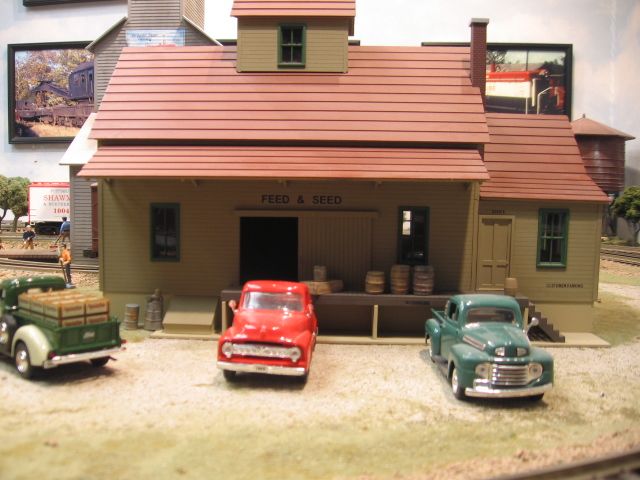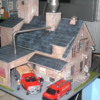Replies sorted oldest to newest
Very nice.
Another great building from Menards. I bet this structure will be finding a home on many "O" Gauge platforms.
Sweet!
Impressive, although I am still kicking myself for not buying the door factory.
Nice, but wish they would have older grain truck to go along.
Just ordered one. Now I have to decide where it will go on the layout.
Nice, but wish they would have older grain truck to go along.
I didn't bother to read. I thought the truck was placed there for the picture. That's a great price, but like you josef, I wish there would have been an older grain truck option especially since with working headlights, I would assume the truck is wired in.
Looks pretty darn nice with an excellent price. Menards keep hitting home runs with their O Gauge train stuff.
Help a city-slicker understand why a feed and grain store has a dust collector. Doesn't the product arrive in bags?
Looks like an excellent value given the photo and description. I'm looking forward to the this week's "reveal" by "Mark the train guy from Menard's" of the hobby shop building.
All these cool buildings coming out and no real estate to put them on the layout! ![]()
WOW.....this is a nice structure!!!!
If this is the direction Menards is going....we may have a new player in the O field.....not just a seasonal merchandiser of toys.
PS....an older truck would be nice for the 2nd edition of this!!!!
From the Menard site. These links usually don't last. Great effort. Wonderful out-of-the-box product.

Menards is really stepping up to the plate.
Help a city-slicker understand why a feed and grain store has a dust collector. Doesn't the product arrive in bags?
A major part of a livestock feed store would be the mill, which grinds grains, corn, oats, wheat, buckwheat, soybean, etc. and mixes the ground grains to different feed product for different animals and purposes. There are portable mills used on the farm. There are also mills on trucks that grind feed at the farms for a fee. Ground feed with supplements wasetter for the animals and animal products.
The dust collector is a necessary part of the mill, even a part of portable mills.
Edit Add: As the grain is hammered in a process mill, a lot of dust is created. The cyclone actually returns a lot of the dust to the product since it is usable feed.
TDN often mentioned, Total digestible nutrients. Also Protein content is monitored.
Processing feed grains has become more sophisticated. Dryers are a huge part of the system now. Grains, corn in particular, harvested late in the year usually has a high moisture content, which can be a problem. High moisture grains will spoil/rot, causing lose of product. Elevator/storage operators will dry the grain for a fee. Also dried grains can be reduced in volume as much as 30%. All taken into product consideration/price. Storage of feed grains is also added to cost. When needed the ground/mixed grain is returned to the farm as animal feed.
Note that at one time addition of large amounts of antibiotics was common. That has been discontinued.
Looks like an excellent value given the photo and description. I'm looking forward to the this week's "reveal" by "Mark the train guy from Menard's" of the hobby shop building.
Just ordered mine eh!
I see no dangling pipe. But you may be looking at the pipe coming up from the back. The front pipe looks to be how the feed etc gets into the truck from the mill. I suspect the pipe from the back (the dangling) gets product up top via a pneumatic pump down below. Runs through the collector and then to the truck.
All these cool buildings coming out and no real estate to put them on the layout! ![]()
I'll second that but my wallet dictates my real estate to.
-Greg
Super nice!
Used to insure these in Va/NC and never saw one with a dust collector. But grain/feed is handled differently in various parts of the country. If mixing feed, dust might be a bigger problem. Maybe in Midwest this is how it is done. Can anyone comment?
If they have a small elevator, there should be a dump pit where trucks unload or possibly some kind of vacuum system. It is hard to tell from the pictures.
Neat building. Ordered one also. Hope there is a way to put lights inside.
Similar to the Walther's offering, without the dust collector. The HO Walter's model has the dust collector.




Walthers HO offering. From the Walthers website.

While I have photographed a lot of them, I have never asked a lot of questions, but I
do know that grain dust can be explosive and has resulted in fires and explosions in
grain elevators, so one or more cyclones (dust separator) are often seen, on elevators and feed mills in the midwest. I just finished a Steam Era Structures feed mill kit, for which I haven't gotten the photos posted on here yet.. I have another feedmill kit to do, also, the Bar Mills "Majestic". The first got and the second will get, a much enhanced elevator. That is exactly what I would do with the Menard's effort, which, to me, looks similar to the Bar Mills version. (however, I don't/didn't need another feed mill)
I love the industrial buildings they have been putting out. I prefer them to the city buildings because I feel it's easier for those of us without talent to put together a standard city building on our own and have it turn out looking good. But harder to make a more complex building like this look realistic.
Another homerun by Menard's. Look at how many guys put in their orders on day one. It's just insane the pace of these releases. It's almost one every couple of months.
That is one sweet building.
Noted somewhat rare grain, buckwheat, is common in Western PA. Usually available, for sale as a pancake flour, about this time of year. Buckwheat pancakes are a sought after breakfast. Heavy in comparison to normal pancakes. More of a stick to your ribs, late winter human feed. ![]() Oats seems to be one of the highest food value grains. Soybean another very high food value grain.
Oats seems to be one of the highest food value grains. Soybean another very high food value grain.
Brady's Run Maple Syrup festival will have buckwheat cakes.
Real estate is an issue on my layout, but I will find the space. Rotate buildings in and out.
Another interesting notes about grain and the railroads. Grain was seasonal. A lot of transportation was needed at one time. The railroads did not have enough special handling hopper cars for grain, and a lot of times, box cars were used to haul grain. Cardboard was used against the sliding doors. to seal the cracks. Once at its destination the cars were opened and the grain removed by hand. Sacked from the farm to the distributor, grains in bags, went away in the late 50's. Products for sale, grains should still be available in bags, but re-usable burlap bags/ now plastic fiber bags are not so plentiful. There was a knot, (Miller's knot), used to close the bags. We were taught as kids, how to tie a miller's knot on the farm. Animal feed in bags tends to be special process disposable paper today, Dog food bags. Hope these few notes add to those with no farm experience. ![]() Mike CT.
Mike CT.
I think I read on here that covered hoppers started to appear in the late thirties? I
also think I read that they became used for grain in the forties? I don't remember
covered hoppers then (just long trains of boxcars, with flats, gons, and open hoppers), but now they are everywhere. Boxcars were used, I assume exclusively, prior to that, with the grain doors (cardboard).
just bit the bullet, now to find a home for it.
very cool,
I like Menards buildings.
As to dust collector. I bought horse feed mixed, 80% oats, 20% corn (corn alone is to hot of a feed). They would blend it for me, and repackage it. Sometimes the CO-OP would re-package, broken or short weight bags. Sometimes they would if short of packaged product, take a grain truck, or wagon load, unload and package with the CO-OP bags.
I guess I need to start stock piling. We are building a house next year and will have some room for a permanent layout! These Menard's buildings are awesome! Thanks Menards for caring about O gauge trains!
The new Feed Mill from Menards is really nice. I will have to strongly consider if I replace it with my currrent feed mill from Walthers. Note that I am calling this a feed mill. I was in the mill business for 25 years, working for my in-laws in Wisconsin. What you are calling a dust collector, isn't necessarily a dust collector at a feed mill! At our mills this is how it worked. A pick up or grain truck or our own shovelvator would bring in a load of corn (as an example) to grind and most times mix concentrates with the ground up corn. Corn would be dumped into a pit and would be dropped into a hammer mill to be ground up. The texture of the ground up corn would be mandated by a screen (like a sieve) with holes in it and depending on how fine or course the feed to be ground was to be, would determine what size screen (diameter of the holes). Attached to the hammer mill was a fan or blower. The ground corn would be sucked into the fan and blown up a pipe which was connected to a cyclone (dust collector as you people are calling them). The heavy corn would then whril around and fall back down into the cyclone, while the air and some dust would exit the upper part of the cyclone. A pipe attached to the bottom of the cyclone would then carry the corn down the pipe into the mill and into a mixer. The mixer would then mix the corn via a verticle auger inside a sleeve where it would come out the top of the sleeve and fall back into the sides of the mixer. Now while the corn is mixing, concentrates would be added to adjust the protein of the feed. Salts and minerals would be added as well, as would liquid molasses to sweeten up the feed, if desired. At our mill you then had two options. You could bag the feed out of the mixer, tie the bags, and put them on a conveyor belt to deliver them out to a farmer in his pick up truck. Or, you could auger the mixed feed out to a bulk delivery truck which had an auger to deliver it like a stoker on a locomotive delivering coal to the firebox of an engine. The other option was to let the bulk feed drop into a farmers grain truck for him to take home in bulk. So this building from Menards is really a feed mill typical of many around the country. I might also add that if you were a farmer, and picked corn out in the field, your picker, could also shell the corn (strip it off the cob), and then take it to a mill that had a dryer to dry the shelled corn. In this instance, the shell corn is dried down to a certain percentage of moisture, and then it is stored in a round steel grain bin in many cases. If the farmer chose to keep the corn on the cob, this type of picker would not shell the corn, then the farmer would elevate the ear corn into a corn crib and let mother nature dry out the cob corn; and then would be ground later. And like one reader mentioned, many farms have their own portable mixer-mills. Where the feed is ground by the power take off of a tractor. The mixer mill has screens too and a small cyclone also, and the farmer mixes his own ingredients and then pulls the mixer-mill to his feed bunkers and augers it into them. The mixer mill eliminated the need to go to a feedmill and have the feed ground and mixed. That is a good reason why so many mills are no longer in business ( like our feed mills) because of the mixer mills. And there are other reasons why the mills are closed, for instance, the family farms in our area continue to dwindle. I hope this lengthy explanation helps out with how a feed mill operates. Nice job Menards, and now I am going to go online and see how much this building costs. By the way, is Mr. Menards dog, Jack, somewhere on the model??
Similar to the Walther's offering, without the dust collector. The HO Walter's model has the dust collector.




Walthers HO offering. From the Walthers website.

Ultimately, I liked mine a lot. I posted pictures of it after i repared some minor damange done in shipping, etc. It is resin, and very heavy, and so a challenge to mount on the layout, but nice.
Attachments
The new Feed Mill from Menards is really nice. I will have to strongly consider if I replace it with my currrent feed mill from Walthers. Note that I am calling this a feed mill. I was in the mill business for 25 years, working for my in-laws in Wisconsin. What you are calling a dust collector, isn't necessarily a dust collector at a feed mill! At our mills this is how it worked. A pick up or grain truck or our own shovelvator would bring in a load of corn (as an example) to grind and most times mix concentrates with the ground up corn. Corn would be dumped into a pit and would be dropped into a hammer mill to be ground up. The texture of the ground up corn would be mandated by a screen (like a sieve) with holes in it and depending on how fine or course the feed to be ground was to be, would determine what size screen (diameter of the holes). Attached to the hammer mill was a fan or blower. The ground corn would be sucked into the fan and blown up a pipe which was connected to a cyclone (dust collector as you people are calling them). The heavy corn would then whril around and fall back down into the cyclone, while the air and some dust would exit the upper part of the cyclone. A pipe attached to the bottom of the cyclone would then carry the corn down the pipe into the mill and into a mixer. The mixer would then mix the corn via a verticle auger inside a sleeve where it would come out the top of the sleeve and fall back into the sides of the mixer. Now while the corn is mixing, concentrates would be added to adjust the protein of the feed. Salts and minerals would be added as well, as would liquid molasses to sweeten up the feed, if desired. At our mill you then had two options. You could bag the feed out of the mixer, tie the bags, and put them on a conveyor belt to deliver them out to a farmer in his pick up truck. Or, you could auger the mixed feed out to a bulk delivery truck which had an auger to deliver it like a stoker on a locomotive delivering coal to the firebox of an engine. The other option was to let the bulk feed drop into a farmers grain truck for him to take home in bulk. So this building from Menards is really a feed mill typical of many around the country. I might also add that if you were a farmer, and picked corn out in the field, your picker, could also shell the corn (strip it off the cob), and then take it to a mill that had a dryer to dry the shelled corn. In this instance, the shell corn is dried down to a certain percentage of moisture, and then it is stored in a round steel grain bin in many cases. If the farmer chose to keep the corn on the cob, this type of picker would not shell the corn, then the farmer would elevate the ear corn into a corn crib and let mother nature dry out the cob corn; and then would be ground later. And like one reader mentioned, many farms have their own portable mixer-mills. Where the feed is ground by the power take off of a tractor. The mixer mill has screens too and a small cyclone also, and the farmer mixes his own ingredients and then pulls the mixer-mill to his feed bunkers and augers it into them. The mixer mill eliminated the need to go to a feedmill and have the feed ground and mixed. That is a good reason why so many mills are no longer in business ( like our feed mills) because of the mixer mills. And there are other reasons why the mills are closed, for instance, the family farms in our area continue to dwindle. I hope this lengthy explanation helps out with how a feed mill operates. Nice job Menards, and now I am going to go online and see how much this building costs. By the way, is Mr. Menards dog, Jack, somewhere on the model??
Thanks for clearing up "dust collector" issue. My mind went blank, I knew it wasn't a "dust collector", just couldn't come up with the word, "cyclone". Cyclones are also used to load covered hopper cars, transfers between silos, and bins, etc.
Again thanks.
I just got Menard's Feed and Seed Store. The picture does not do it justice. I just love it. If this is any indication of the quality of their Buildings, I will be buying more. If Menard's made available a coal distribution store, it would definitely be my next buy.
I agree with most in that the vehicle should be of an older model. I will be replacing their vehicle with a vehicle I purchased from Starbucks seven (?) years ago that more closely represents the building.












